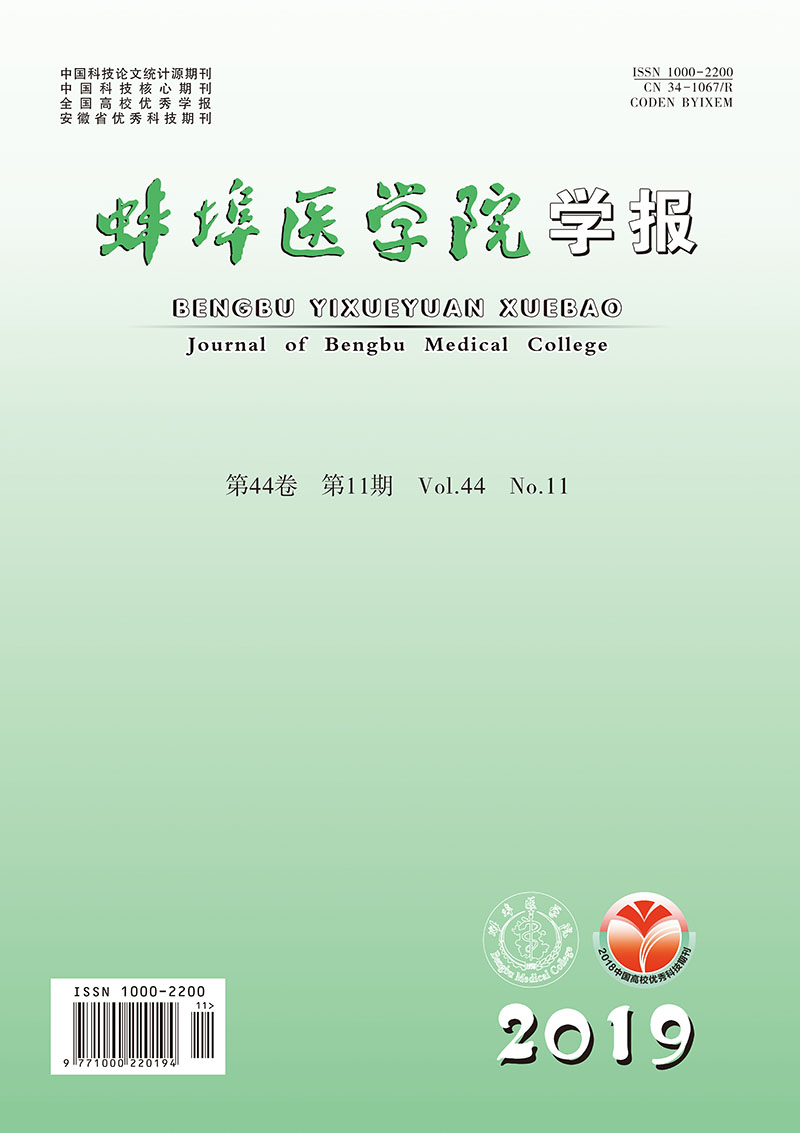-
桥本甲状腺炎(Hashimoto thyroiditis, HT)是最常见的自身免疫性甲状腺疾病[1],以血清中存在高滴度的甲状腺过氧化物酶抗体(thyroid peroxidy antibody, TPOAb)和甲状腺球蛋白抗体(thyroglobulin antibody, TgAb)以及甲状腺组织中大量淋巴细胞浸润为特点,最终出现甲状腺滤泡结构破坏和甲状腺功能减退。HT发病率近年来呈逐渐上升趋势,好发于30~50岁女性[2]。有研究[3]认为,HT氧化应激水平升高,抗氧化及免疫调节能力减弱,造成甲状腺滤泡上皮细胞(thyroid follicular epithelial cell, TEC)氧化及免疫损伤,诱发或加重HT病情。然而HT的发病机制仍未完全明确,治疗上仅局限于对症处理,甲减病人给予左甲状腺素钠片替代治疗后可减轻甲状腺肿、改善甲状腺功能[4],但对于高抗体滴度疗效不佳[5],对甲状腺其他炎症损伤的作用及机制也不清楚,尚无阻止病情进展作用的证据。本文主要探讨硒能否改善HT病情及其对HT氧化及抗氧化系统的作用。
HTML
-
选取2015年5-8月于蚌埠医学院第一附属医院就诊的HT病人,共60例,诊断依据采用《中国甲状腺疾病诊治指南》中的HT诊断标准[6]。年龄10~64岁,其中男4例,女56例。另随机选取同期我院健康体检者30名为正常对照组(NC组),年龄22~59岁,其中男5名,女25名。所有入选对象均排除严重的心肝肾疾病、神经和精神系统疾病以及哺乳期、妊娠期妇女。入选的HT病人随机分为补硒组(A组)和左甲组(B组),再分为甲功正常的A1、B1亚组和甲减的A2、B2亚组。本研究在实施前已通过该医院临床医学研究伦理委员会的审查。临床试验注册:中国临床试验注册中心ChiCTR-IPR-15006442。
-
采取硒酵母辅助左甲状腺素钠片(优甲乐,德国默克药业公司,注册证号H20140052)治疗维持TSH在正常范围(0.4~4.0 mIU/L)基础上,联合硒酵母胶囊(富希康,芜湖华信生物药业股份有限公司,国药准字H20052532)治疗,每次200 μg,每日2次,口服,以3个月为观察时间。询问有无药物不良反应,提醒病人服药期间不用免疫调节剂等对治疗有影响的药物。
-
采用口服左甲状腺素钠替代治疗维持TSH在正常范围。B1亚组每次25 μg,每日1次,B2亚组从25~50 μg开始,每日1次;间隔1~2周后根据甲状腺功能增加25~50 μg,维持剂量50~150 μg,每日1次。观察3个月。
-
(1) 甲状腺功能:总三碘甲状腺原氨酸(TT3)、甲状腺素(TT4)、TSH, 采用化学发光法检测;(2)甲状腺自身抗体:TgAb、TPOAb采用放射免疫法检测(天津市协和医药科技集团有限公司);(3)血清硒:采用原子荧光光谱法检测,检测仪器为北京吉天仪器有限公司AFS-9130双道原子荧光光度计;(4)氧化及抗氧化指标:丙二醛(MDA)、谷胱甘肽过氧化物酶活性(GPX),分别采用硫代巴比妥酸比色法、二硫代二硝基苯甲酸直接法检测(南京建成生物工程研究所)。以上指标治疗前后各检查1次。
-
采用t检验、方差分析、秩和(Mann-Whitney U或Kruskal-Wallis H)检验、χ2检验、双变量相关分析(Pearson积差相关分析或Spearman秩相关分析)。
1.1. 研究对象
1.2. 治疗方法
1.2.1. A组
1.2.2. B组
1.3. 观察指标
1.4. 统计学方法
-
HT病人共60例,其中A组34例,B组26例。NC组共30例。各组年龄、性别差异均无统计学意义(P>0.05)(见表 1)。
分组 n 女 男 年龄/岁 A组 A1亚组 19 17 2 32.63±12.26 A2亚组 15 15 0 36.00±13.43 B组 B1亚组 16 14 2 38.56±14.76 B2亚组 10 10 0 41.00±16.36 NC组 30 25 5 35.23±10.12 合计 90 81 9 36.04±12.75 F — 4.38* 0.90 P — >0.05 >0.05 MS组内 — — 163.267 *示χ2值 -
治疗前HT各组血硒水平明显低于NC组(P < 0.01),其中A1、B1亚组分别高于A2、B2亚组(P < 0.05)。治疗后血硒水平升高值A组及其亚组明显高于B组及其亚组(P < 0.01)(见表 2)。
分组 n 治疗前 治疗后 治疗前后差值 M P25 P75 M P25 P75 M P25 P75 A组 A1亚组 19 36.49** 22.17 43.78 86.45# 80.78 94.12 52.43△△ 44.97 66.12 A2亚组 15 18.63** 17.09 23.51 95.84# 80.43 116.84 67.75△△ 41.47 101.11 B组 B1亚组 16 26.30**▲ 21.93 42.18 40.62 31.80 53.95 8.09 -3.49 16.88 B2亚组 10 13.17**+ 10.13 47.46 36.91 24.17 51.10 10.82 5.18 25.96 NC组 30 103.12 98.02 109.87 — — — — — — Hc — 64.98 — — 39.49 — — 39.12 — — P — < 0.01 — — < 0.01 — — < 0.01 — — 治疗前:与NC组比较**P < 0.01;与A1亚组比较▲P < 0.05, 与A2亚组比较+P < 0.05, 治疗后与治疗前比较#P < 0.05, 与B组比较△△P < 0.01 -
治疗前,A1、B1各亚组的TT3与TT4水平均高于B2组(P < 0.05),TSH水平低于B2组(P < 0.01);治疗后,A2、B2亚组TSH水平降低(P < 0.05),A2亚组TT4水平升高(P < 0.05),其余各组甲状腺功能变化差异无统计学意义(P>0.05)(见表 3)。
分组 n TT3(x±s;ng/mL) TT4[M(P25~P75);ng/mL] TSH[M(P25-P75);mIU/L] 治疗前 治疗后 治疗前 治疗后 治疗前 治疗后 A组 A1亚组 19 1.14±0.23* 1.10±0.28 87.00*(75.23~99.10) 81.50(76.70~97.40) 1.80**(0.85~2.59) 1.43(1.05~2.42) A2亚组 15 1.03±0.07 1.15±0.23 68.00(60.24~82.70) 85.29(68.80~92.80) 8.61*(5.31~13.5) 2.68△(2.43~3.73) B组 B1亚组 16 1.17±0.24* 1.08±0.24 82.20*(56.26~99.84) 88.42(71.11~98.69) 1.17**(0.57~1.84) 1.20(0.59~170) B2亚组 10 0.87±0.31 1.04±0.2 53.67(24.54~64.78) 66.11(58.05~96.23) 15.03(6.77~42.25) 3.33△(3.01~3.72) Hc — 4.80 0.41 14.32 1.38 44.28 27.39 P — < 0.01 >0.05 < 0.01 >0.05 < 0.01 < 0.01 MS组内 — 0.049 0.06 — — — — q检验:与B2亚组比较*P < 0.05, **P < 0.01;组内配对符号的秩和检验:△P < 0.05 -
治疗前,TPOAb及TgAb水平在A、B各亚组之间差异均无统计学意义(P>0.05);治疗后,A1和A2亚组TPOAb及TgAb水平均明显降低(P < 0.01),B组中仅有B1亚组TgAb水平下降(P < 0.05),余亚组TPOAb及TgAb水平变化无统计学意义(P>0.05)。治疗后,A1和A2亚组的TPOAb及TgAb水平降低幅度均高于B2亚组(P < 0.01),其他亚组间降低幅度差异均无统计学意义(P>0.05)(见表 4)。
分组 n TPOAb TgAb 治疗前 治疗后 治疗前后差值 治疗前 治疗后 治疗前后差值 A组 A1亚组 19 35.12±5.47 24.92±11.23## 10.20±11.11 52.85±9.64 38.08±18.21## 14.77±17.21 A2亚组 15 31.73±8.22 22.00±6.08## 9.73±5.87 47.33±11.47 33.00±10.18## 14.33±8.28 B组 B1亚组 16 34.50±8.26 29.48±9.42 5.01±7.60 50.26±8.95 40.87±11.91# 9.39±10.58 B2亚组 10 34.42±9.64 36.02±11.14*△△ -1.59±7.58*△△ 53.28±15.16 52.83±15.12*△△ 0.45±8.95*△△ F — 0.60 4.86 5.04 0.90 3.96 3.41 P — >0.05 < 0.01 < 0.01 >0.05 < 0.05 < 0.05 MS组内 — 59.740 93.513 73.002 121.175 207.246 155.188 q检验:与A1亚组比较*P < 0.05;与A2亚组比较△P < 0.05,△△P < 0.01。组内配对t检验:#P < 0.05,## P < 0.01 -
治疗前,HT病人MDA水平高于NC组(P < 0.05),而GPX活性低于NC组(P < 0.05)。治疗后,A组MDA水平降低值明显高于B组(P < 0.05),但亚组间差异无统计学意义(P>0.05);A组及其亚组GPX活性升高值高于B组及其亚组(P < 0.05~P < 0.01)(见表 5)。
分组 n MDA水平[M(P25~P75); nmol/mL] GPX(x±s; 酶活力单位) 治疗前 治疗后 治疗前后差值 治疗前 治疗后 治疗前后差值 A组 A1亚组 19 8.58*(6.42~12.09) 4.52#(3.45~5.24) 3.82(2.39~7.57) 96.43±40.35* 138.44±29.51# 42.01±19.94△ A2亚组 15 7.18*(5.82~9.20) 4.86#(3.19~5.81) 2.06(0.55~4.12) 99.84±43.50* 134.17±37.41# 34.33±28.12△ B组 B1亚组 16 7.28*(5.70~10.90) 6.06(5.38~8.62) 0.44(-1.31~3.71) 99.76±47.92* 113.01±30.12 13.26±41.32 B2亚组 10 6.54*(4.61~10.29) 5.52(4.75~6.27) 1.04(-1.32~4.93) 112.88±50.99* 114.00±23.60 1.12±40.54 NC组 4.30(3.61~4.83) 144.21±44.65 — — Hc — 45.93 15.38 7.58 4.88 2.79 4.68 P — < 0.01 < 0.01 >0.05 < 0.01 < 0.05 < 0.01 MS组内 — 2 016.923 962.109 1 047.076 q检验:与NC组比较*P < 0.05,与B组比较△P < 0.05;组内配对检验:与治疗前比较#P < 0.05 -
治疗前,HT病人血硒水平与TT4呈正相关关系(r=0.294,P < 0.05),与TSH呈负相关关系(r=-0.343,P < 0.01),其余指标间无明显相关性(P>0.05)。
2.1. 各组一般资料比较
2.2. 各组治疗前后血清硒水平变化的比较
2.3. 各组治疗前后甲状腺功能变化的比较
2.4. 各组治疗前后甲状腺自身抗体水平变化的比较
2.5. 各组治疗前后MDA水平及GPX活性变化的比较
2.6. 各观察指标相关性分析
-
HT是一种器官特异性自身免疫性疾病[7],其发病机制目前尚未完全明确,缺乏病因学的治疗方法。硒是人体必需的微量元素,甲状腺是人体中含硒量最高的器官之一[8],硒在甲状腺激素的合成、代谢以及活化过程中具有重要作用[9-10]。含硒蛋白酶中的GPX具有强大的抗氧化作用,可清除甲状腺内多余的氧自由基,维护细胞膜的完整性,同时也影响甲状腺激素的合成[11]。另一种硒酶脱碘酶参与甲状腺激素的代谢。在HT中,TSH水平升高以及淋巴细胞分泌的细胞因子可诱发氧自由基生成增多[12],而缺硒时,GPX活性下降,不能及时消除氧自由基,从而引发脂质过氧化作用,MDA水平因而升高,造成TEC氧化损伤,这可能是HT发病的重要机制。补硒后,GPX活性升高,机体抗氧化作用增强,多余的氧自由基被消除,TEC氧化损伤可能得到减轻。
本研究显示HT病人血硒水平低于一般健康人群,补硒可明显升高血硒水平,与其他学者[13-14]的报道相一致。一些研究显示补硒可改善HT病人甲状腺功能[15-17],本研究中甲功改善程度补硒组与左甲组无明显差异,可能是由于实验中各组均服用优甲乐维持甲功在正常范围。但基线状态下HT甲减病人血硒水平低于甲功正常者,且HT病人血硒水平与TT4呈正相关关系,与TSH呈负相关关系。这说明甲减越重,血硒水平越低,血硒水平可能影响甲状腺激素的合成。治疗后补硒组甲状腺自身抗体(TPOAb、TgAb)明显降低,而左甲组下降不明显。亚组中抗体水平降低值甲减组(A2与B2亚组)比较差异有统计学意义,甲功正常组(A1与B1亚组)间差异无统计学意义,这提示硒干预有助于降低HT病人甲状腺自身抗体滴度,尤其是甲减的病人,这与刘坤等[15-16, 18-20]研究结果相似。治疗前HT病人MDA水平明显高于NC组,GPX活性则相反;治疗后补硒组MDA水平明显下降,GPX活性明显升高,而左甲组两个指标变化不明显。这证实了HT病人抗氧化防御能力降低,氧化水平升高,与文献[3]报道一致,而硒干预可减少氧化损伤。MDA水平降低值A组与B组差异有统计学意义,但可能由于各亚组例数较少、观察时间较短,亚组间差异无统计学意义。
综上所述,补硒有助于降低病人甲状腺自身抗体滴度,同时增强机体抗氧化能力,减少氧化损伤,从而改善病情,且目前研究中补硒无明显不良反应发生,提示硒可作为HT治疗的新切入点。但也有小部分病人及其他研究报道[21-22]补硒效果不佳,是个体对硒治疗的反应性差异还是与其本身的硒或碘水平等有关,有待进一步研究。






 DownLoad:
DownLoad: